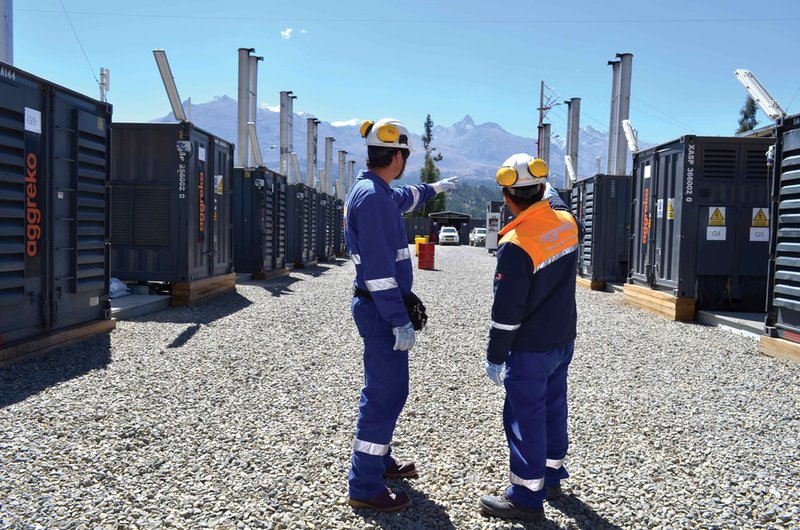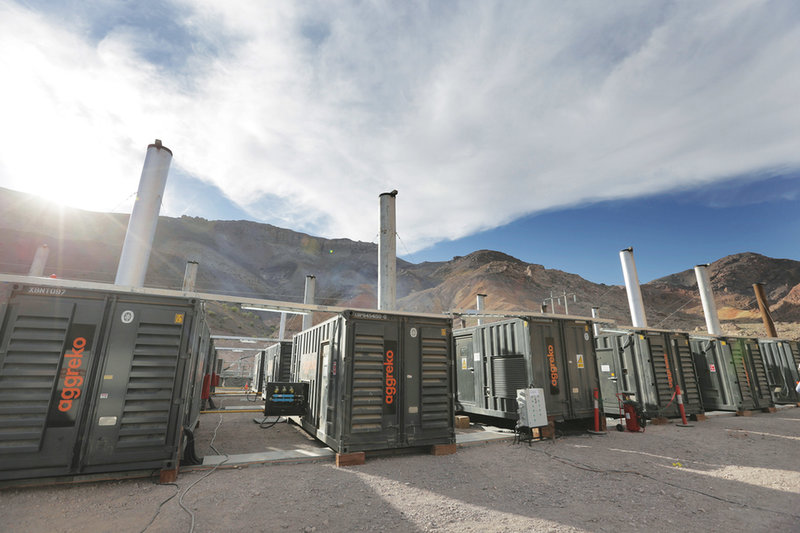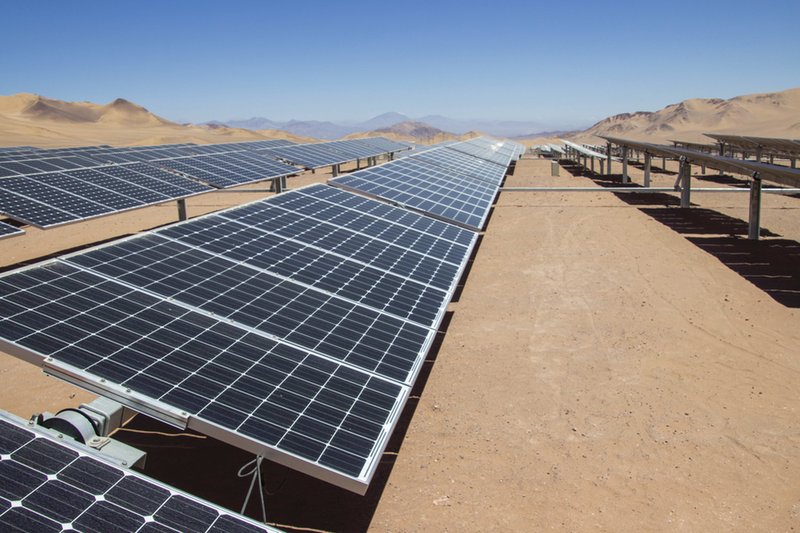
Q&A | PROJECT FOCUS
Mining, renewables, and gold high in the Andes with Aggreko
More than 4.5km above sea level, high in the Andes Mountains, Gold Fields operates the Salares Norte project. The gold mine lies 180km from the nearest town and airstrip, making site logistics challenging. Aggreko supplies the site’s power, using a hybrid of diesel generators and solar power. Matt Farmer speaks to Dagan Baroco, head of commercial at Aggreko Latin America, about bringing renewables to new heights.
F
or the Salares Norte project, Aggreko installed 9.9MW of solar generation, alongside 16MW of diesel generation. The company estimates that the project will lead to savings of $7.4m on the cost of energy over the next ten years, as well as $1.1m savings on carbon taxes. Aggreko Latin America’s head of commercial Dagan Baroco says that he believes solar has a big future in mining.
//Karan Rathi, board director at Chillerton Group.
Credit: Chillerton Group
//Dagan Baroco, head of commercial at Aggreko Latin America. Credit: Aggreko
Matt Farmer: What specific challenges did the Salares Norte project present?
Dagan Baroco: We’ve had a business in Chile since the early 2000s. It has been a primarily mining-based operation, so we have sites very similar to Salares Norte at very high altitudes, very remote locations.
We set up a base at the site for our operators to work from in rotation. We also have remote operations and control systems that we can use in situations like this.
That allows real-time monitoring from our main hub in Santiago and in our operational hub in Antofagasta. That provides a level of access to Salares Norte, and our team is quite experienced in the challenges that we would see there.
We have to think about consumables, spares, and everything that we need to maintain our power plants and keep them operational. We have strategic stocks and strategic workshops that are physically in the mines, so we have everything that we need there. We're working with a buffer of actual materials.
Usually we have around 90 days of consumables always in inventory, and in more remote locations that can be extended to 120 days. In the winter months, there can be additional measures taken due to the logistics of getting out to the high altitudes, which can pose some additional challenges.
At most of these high-altitude locations in Latin America, you will see challenges in the winter from roadways, because it's gonna snow and ice up.

// Aggreko previously worked with Gold Fields at other projects, such as in Australia.
The Government of Chile mandates that 20% of the country’s energy should come from renewable sources by 2025. Given the options, why did you choose solar and why this amount?
We initially bid on this project in 2018, and at that time the request was for thermal only. Towards the end of 2019, Aggreko was looking at pushing out our hybrid offering and we had the discussion with Gold Fields about the potential to look at photovoltaic (PV) power for this project.
It really evolved from there. The benefits that we started to see from putting PV in a hybrid solution for this project meant a net saving, including on fuel. It also provides the reduction in carbon emissions, which aligns with what the Chilean government's looking for, as well as what Gold Fields is looking for.
Obviously, you've got to have some power on demand that solar cannot necessarily provide. So, we will have some constant power from thermal resources [diesel], but we will deploy most of the power on solar.
The design was really to meet most of their demand with solar but not have any risk of excess solar generation at any given point in time. At this project, we don’t have energy storage, so it would need to be consumed at the time of generation.
On a more general level, there's a huge amount of solar projects being deployed in Chile; it has some of the best conditions for solar in the world. It's becoming a preferred solution for many mines and looking at the modelling, it made economic sense.
We had the space that was required. Wind can be variable but solar has a more reliable penetration in that region.

// The diesel generators, which will offer a more flexible supply of power.
How did you take account of the variable power requirements a mine can have?
The modular design that we have with the thermal generators allow us to react to that variable load requirement. This is integrated together with a single control solution, so one of the benefits of our hybrid solution is that we have the ability to adapt to the variable load.
Our diesel assets on site at that altitude are generating about 770kW each. That it allows us to have some constant reserve power and adjust to any variations in load.
We can optimise for solar generation during the day,and if there are any reductions to the solar, we can offset with thermal and ensure a continuous supply of power.
How much does the balance between renewable and thermal generation vary between projects?
It does vary. For example, we had the ability to bring in a virtual gas pipeline. It's something we're looking very closely at in Chile, trying to displace diesel with virtual pipelines.
That's something that we continually look at, because we can transition to gas if need be. That’s an added level of flexibility that we can have, and that can happen during an operational term when the fuel could become available.
A lot of it is around fuel availability and logistics. We've done a number of gas transition projects globally, which has a great knock-on effect on the cost of generation but also a knock-on effect of reduction in carbon emissions.
The issue is the location of the supply of gas and how we can build a virtual pipeline to the point of use. If we have a source of LNG and a partner that we can work with to deliver it, we can work within 800km.
The gas may or may not be within those parameters and it may not be in a liquid form. And that can mean restrictions if we have to compress gas, but we're seeing more gas becoming available on many of the markets where we operate, and there's a demand for it.
// Main image: 3D System Model and Completed Installation. Credit: Deimos

// Aggreko will supply and maintain the 9.9MW solar installation.
Do you expect more mines to adopt solar generation?
We expect it to increase quite significantly in the coming years. It's becoming easier to integrate with other sources of generation, so that's allowing high levels of available power at mining operations.
Integrating solar with thermal, and having the reduced cost of solar, provides a very efficient cost of energy and also provides a reduction in carbon emissions. Many of these mines will have been operational for 10 years or 20 years, and it fits quite nicely into that profile of a lifecycle of mine.
With Aggreko, we have a quick, deployable thermal solution, we always have. But now, bringing in the elements of PV and deploying that as well, it's making that discussion a lot more interesting with our customers.
Not depending on a very long transmission line from the national grid at remote locations means you can accelerate a project. We've seen many mines in the past that have had massive delays in operations due to complications with running very long transmission lines out.
I think today, mines have become more truly like an island operation, and that takes out elements of risk and complexity, that in years past, maybe weren't available. Or instead, you were looking at a very costly source of generation if it was diesel only.
This is changing the discussion, and it’s something that we hope to use as a reference and take this discussion to other customers that have remote applications similar to this in the mining industry.
That can allow us to be a full service provider for power, and basically pay on a kilowatt-hour basis, which I think is quite an interesting value proposition for many of these mining companies.
// All images Credit: Aggreko